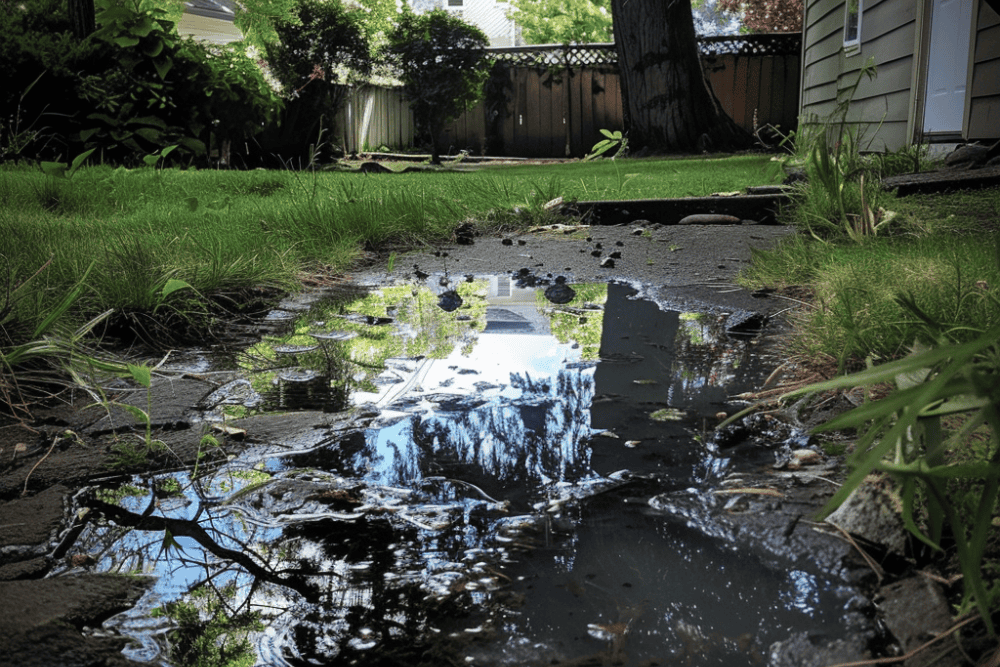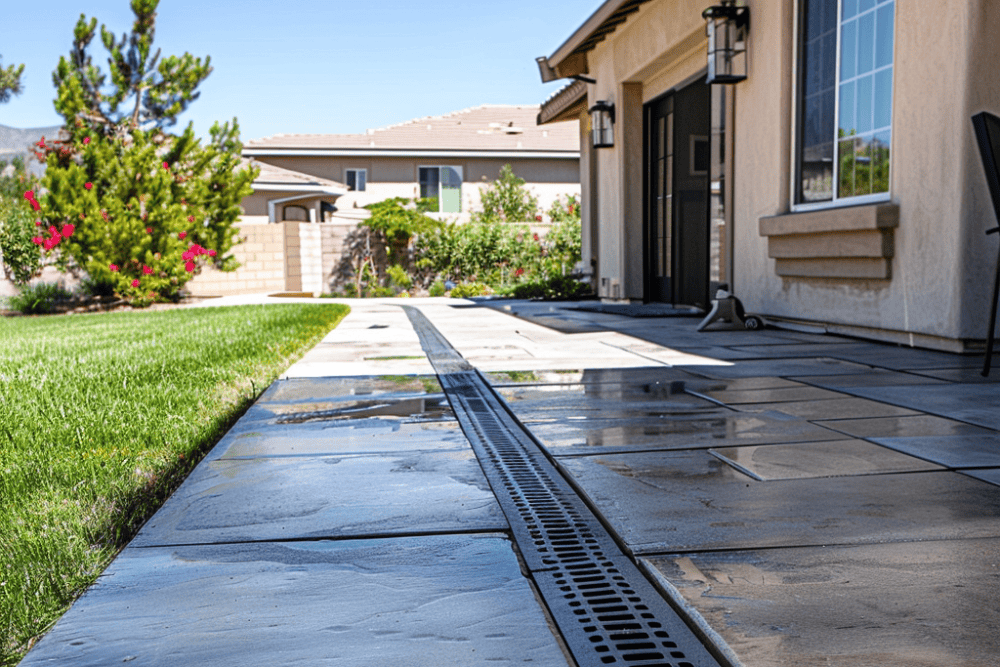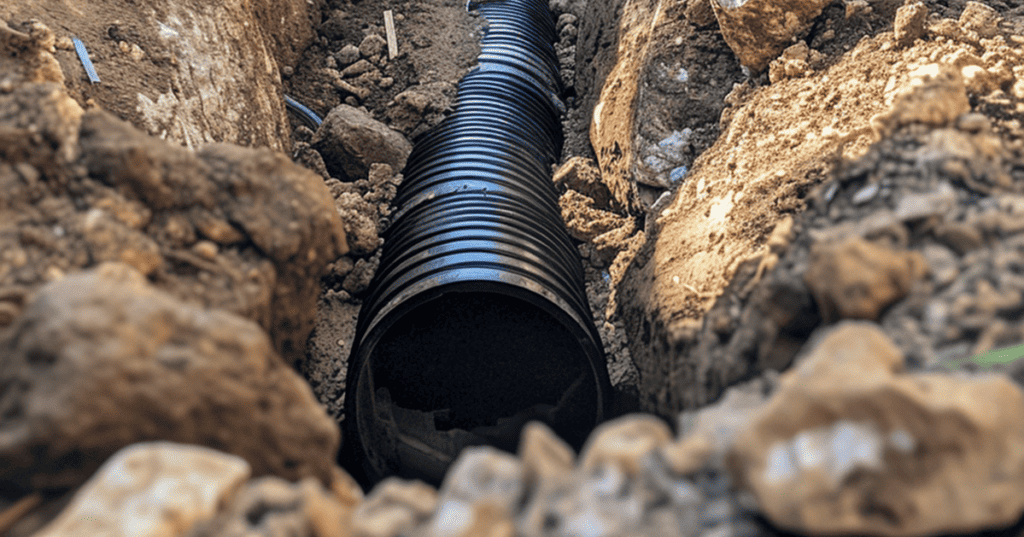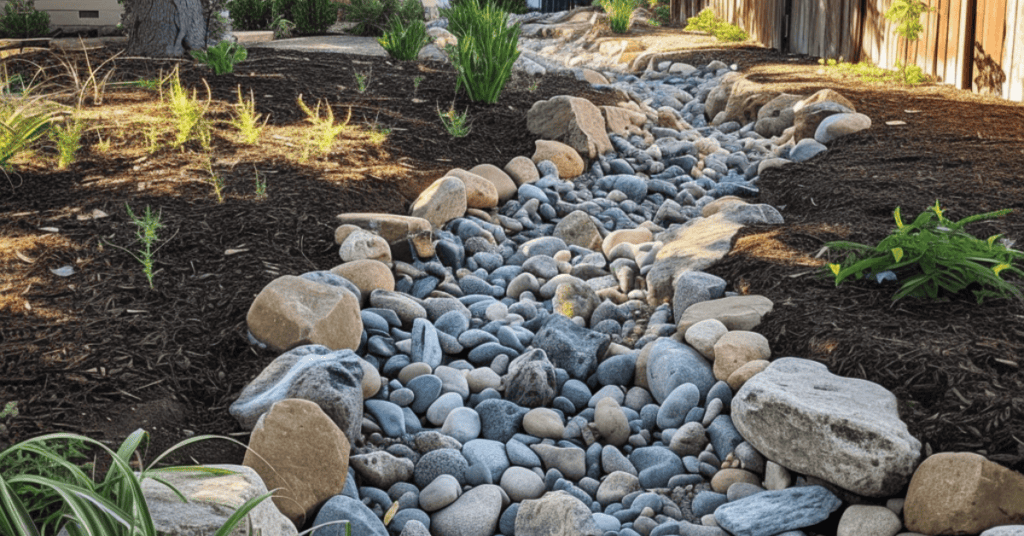French Drains
Components of a French Drain
French drains are a drainage solution that helps to manage excess water by directing it away from specific areas to an outlet where it doesn’t adversely impact your property or nearby properties. They prevent water buildup, erosion and damage from water runoff.

A French Drain is a subsurface water drainage solution that can direct water away from structures like your home – and drains can also be installed to eliminate water pooling in your yard.
A French drain consists of several key parts: a trench, gravel, a perforated pipe, and a geotextile fabric.
- Trench: The trench is a shallow ditch dug into the ground. It is slightly sloped and directs water flow from high to low areas. Note that while a trench is dug for a French drain, it is not a true “trench drain” as the trench is filled in with a pipe, gravel and soil. A channel drain – which we cover in a moment – is a true trench drain – in that it is a trench that is covered by a grate.
- Gravel: Landscaping fabric is used to line the trench for the French drain. This landscaping fabric helps to prevent soil and dirt from entering the French drain pipe. Then gravel is added which lines the bottom and sides of the trench. It allows water to flow toward the perforated pipe while preventing soil from clogging the system.
- Perforated Pipe: The pipe has holes (perforations) that allow water to enter. This pipe carries water away from the area, typically to a safe drainage point. The pipe is surrounded by a mesh sock that prevents soil and debris from entering the french drain pipe.
Once installed, you’ll want to test the french drain to make sure that water flows as intended.
How a French Drain Works
French drains collect groundwater and surface water runoff. They’re great for yard drainage as well as to keep water from the foundation of your home.
Water enters the trench through gaps in the soil surface. The gravel filters out debris while letting water pass through to the perforated pipe.
The perforated pipe collects the water and channels it away. The geotextile fabric acts as an additional barrier, preventing soil particles from entering and clogging the system.
You need to regularly inspect and maintain your French drain to ensure it remains effective. Blockages and clogs can end up with you experiencing a drainage problem, so you’ll need to regularly inspect and maintain your French drain to ensure it remains effective. Be sure to clear any debris that may accumulate around the openings. By doing so, you help maintain proper drainage and prevent potential water damage.
Channel Drains
A channel drain is a surface drain that not surprisingly works well for managing surface water. Also called a trench drain, these drains often feature materials like concrete, plastic, and metal, each making them suitable for different heavy-duty applications. 
A channel drain provides surface drainage in and around hardscape elements like patios, walkways and driveways
Structure of Channel Drains
Channel drains typically have a long, narrow shape. They can be made from concrete, plastic, or metal. This construction allows them to handle various water flows.
The channels in these drains come with grates on top. These grates can be plastic, metal, or concrete, based on the load they need to bear. More durable materials, like metal grates, handle heavy traffic better.
Channel drains often fit together in a trench, forming a continuous line. This design makes them perfect for large areas, like parking lots or sports fields.
Operational Mechanism of Channel Drains
Channel drains collect and direct surface water away from paved or hardscaped areas. They trap rainfall and runoff in the channels. The sloped design guides water into the drainage system.
You will create a sloped trench along the area that you want to drain. Depth of the trench will vary, but typically it should be at least six inches deep. You’ll then place the channel drain within this shallow trench. Gravity helps water flow through the channel. The drain then is connected to a drain pipe where it carries the water into a designated drainage area or sewer.
On top of the channel drain is a grates cover the channels. They keep debris out, ensuring smooth water flow. High-quality grates last longer and need less maintenance. You’ll want to make sure that the grates fit snugly on to the drain to avoid any tripping hazards. Channel drains are typically located in or near hardscapes that have a relatively high amount of foot traffic.
Comparing Effectiveness and Uses
Effectiveness in Water Management
French drains work well in areas with high water tables. They collect subsurface water and divert it away. They can also handle surface water if you install a grate as part of your French drain system. They are useful for keeping water away from basements and preventing flooding in lawns.
Channel drains handle surface water efficiently and are commonly installed adjacent to or within hardscape elements like patios and driveways. They are ideal for places where water collects and creates pools. These drains have a long, linear design that makes them perfect for driveways, parking lots, and landscaping projects. Their effectiveness lies in their ability to quickly remove water from hard surfaces, reducing the risk of slippery conditions.
Addressing Common Concerns
French drains and channel drains help manage and direct water away from your property. Both systems can encounter specific issues. Here, you’ll learn about potential complications and how to prevent water damage with these drainage systems.
Potential Complications
Clogging: French drains may clog due to soil, debris, or roots. Regular cleaning helps prevent this issue. Inspect your system after heavy rains to ensure it’s clear.
Poor Installation: Incorrectly installed drains can lead to water pooling instead of directing it away. Ensure your system slopes properly to guide water out effectively.
Erosion: Improperly positioned drains can cause soil erosion. Place your drain in a way that minimizes soil movement.
Foundation Issues: If water doesn’t drain correctly, it might collect near your foundation. While basement waterproofing can be helpful in wet areas, an even better idea is to ensure that water flows away from your home to avoid structural problems.
Preventing Water Damage
Regular Inspections: Check your drains regularly for blockages and damage. Catching problems early prevents long-term water damage.
Proper Maintenance: Clean and maintain your drains to keep them effective. Remove leaves, debris, and soil that could block water flow.
Strategic Placement: Position your drains to address areas prone to water accumulation. Low-lying spots, areas near foundations, and places with poor drainage benefit most.
Combat Mold and Mildew: Standing water can cause mold and mildew. Ensure proper drainage to keep these issues at bay. Monitor your property for signs of dampness or odor.
Implement these tips to maintain an effective and reliable drainage system, protecting your property from water damage and erosion.
Frequently Asked Questions
When is it more appropriate to use a channel drain instead of a French drain?
Use channel drains in areas with heavy surface water, like driveways or patios. They efficiently handle large volumes of water quickly, unlike French drains, which are better for groundwater control.
What are the key considerations when deciding between a channel drain and a French drain for water management?
Consider the location, water volume, and installation cost. French drains are better for large areas with groundwater issues. Channel drains handle heavy surface water, especially in paved locations, but installation can be costly.
How does the installation process compare between French drains and channel drains?
French drain installation involves digging, laying pipes, and filling with gravel. Channel drains require trench digging, but involve setting a pre-formed channel, usually made of concrete or plastic. This makes channel drains faster to install.
What is the Difference Between a Slot Drain and a Channel Drain?
Both drains are surface drains that are adept at capturing excess surface water and transporting it to an area where it won’t damage nearby property. The main difference is that a slot drain has a very narrow, long, linear opening at the surface which integrates a bit better with the surrounding surface – when compared to a channel drain which has a very noticeable surface grate. Another difference is that due to its narrow opening, a slot drain may be more impacted by debris and clogs than a slot drain.

